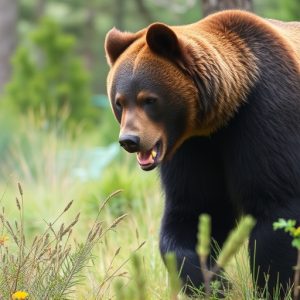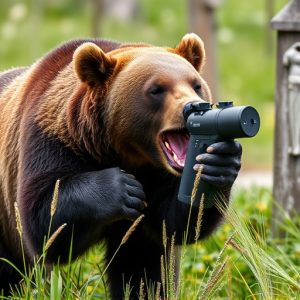Bear Deterrent Spray Range: Science and Factors vs. Pepper Spray Power
Bears, particularly grizzlies, pose significant risks due to their power and unpredictable nature. B…….
Bears, particularly grizzlies, pose significant risks due to their power and unpredictable nature. Bear spray, a type of pepper spray containing capsaicin, is an effective deterrent by overloading a bear's sensitive olfactory system. Unlike common belief, bear spray is not hotter than regular pepper spray but offers stronger protection with a range up to 7–8 meters (23–26 feet). Its potency and unique formulation make it superior for deterring bears compared to traditional pepper spray. The effectiveness of bear spray depends on ingredient concentration, weather conditions, terrain, and bear species behavior. Understanding these differences is crucial for hikers and outdoor enthusiasts navigating bear-inhabited areas.
“Discover the power of bear deterrent spray—a vital tool for outdoor enthusiasts navigating bear country. Understanding bear behavior and their sensitivity to specific irritants is key to effective deterrence. This article explores the science behind bear spray, delving into its range and potency compared to pepper spray. We’ll examine factors influencing spray reach and provide insights on choosing the right protection. By the end, you’ll grasp why bear spray can be a game-changer in ensuring safe encounters.”
- Understanding Bear Behavior and Their Sensitivity to Spray
- The Science Behind Bear Deterrent Spray Effectiveness
- Factors Affecting the Range of Bear Spray
- Comparison: Pepper Spray vs Bear Spray Performance
Understanding Bear Behavior and Their Sensitivity to Spray
Bears, especially grizzlies, are powerful and unpredictable animals with a strong sense of territory. Understanding their behavior is crucial when considering bear deterrent spray as a safety measure. These sprays are designed to create a temporary but effective barrier between you and the bear by targeting their sensitive olfactory system.
Bear spray, often referred to as pepper spray, utilizes capsaicin, the same compound found in hot peppers, to cause irritation and discomfort. Unlike some myths, bear spray is typically not “stronger than pepper” in terms of heat sensation; instead, it focuses on overwhelming the bear’s sense of smell. When a bear detects the distinct odor of the spray, it may become disoriented and choose to retreat rather than attack. The maximum range protection offered by these sprays can vary, but they are designed for use at close to intermediate distances, ensuring that users have time to deploy the spray effectively while maintaining safety.
The Science Behind Bear Deterrent Spray Effectiveness
The effectiveness of bear deterrent spray, often referred to as bear spray, lies in its unique composition and ability to deter aggressive bears. Unlike traditional pepper spray designed for human self-defence, bear spray is specifically formulated to repel bears. It typically contains capsaicin, the same ingredient that gives chili peppers their heat, but in much higher concentrations. This powerful compound irritates a bear’s eyes, nose, and throat, creating an intense sensation of pain and encouraging it to retreat.
When compared to regular pepper spray, is bear spray stronger? Absolutely. Bear sprays are designed to be more potent to effectively deter larger, more powerful animals like bears. The maximum range protection offered by these sprays allows users to keep a safe distance while still being able to apply the spray effectively. This makes it a crucial tool for outdoor enthusiasts and individuals living in bear country, providing them with an additional layer of safety and peace of mind.
Factors Affecting the Range of Bear Spray
The range of bear deterrent spray, often referred to as bear spray, is influenced by several factors. One key consideration is the concentration and strength of the pepper-based ingredients in the spray. While it’s commonly believed that bear spray is stronger than regular pepper spray used for human self-defense, this isn’t always the case. The effectiveness and range can vary based on the specific formula and active ingredients. Some high-quality bear deterrents contain capsaicin, the active compound in chili peppers, at higher concentrations designed to deter bears.
Other factors impacting the range include weather conditions, terrain, and the bear’s behavior. On a hot day, the spray might dissipate faster due to evaporation compared to colder temperatures. Rough terrain or dense vegetation can also reduce the reach of the spray. Additionally, different bear species have varying reactions to pepper spray; for instance, black bears might be less affected than grizzly bears. Therefore, understanding these factors is essential for determining the optimal range and ensuring maximum protection when venturing into bear country.
Comparison: Pepper Spray vs Bear Spray Performance
When it comes to bear deterrents, understanding the performance differences between pepper spray and bear spray is essential for hikers and outdoor enthusiasts. Many people wonder, “Is bear spray stronger than pepper spray?” The answer lies in their unique compositions and effects. Pepper spray, popular for self-defense against humans, uses capsaicin, the active ingredient in chili peppers, to cause a burning sensation and temporary blindness. It has an effective range of about 2–3 meters (6–10 feet).
Bear spray, on the other hand, is specifically designed to deter bears by targeting their sense of smell and vision. It contains capsaicin as well but is mixed with other ingredients like black pepper oil and citruses to create a stronger, longer-lasting effect. Bear spray can be effective up to 7–8 meters (23–26 feet), making it a more powerful option for dealing with larger bears and providing maximum range protection.
Bear deterrent spray has proven to be an effective tool for personal safety in bear country, offering a non-lethal means of protecting against potential attacks. Understanding the science behind its effectiveness and the factors influencing its range is key to maximizing protection. In comparison to pepper spray, bear spray offers specialized components tailored to deter bears, making it a more potent option. While the maximum range varies based on conditions, proper usage techniques, and product quality, knowing these variables can help individuals make informed decisions to ensure safety during outdoor activities in bear habitats.


